Best Canelés de Bordeaux (Cannelés) recipe
“Though this be madness, yet there is method in’t.” – William Shakespeare, Hamlet. Yes indeed there is, and it nearly drove me mad on the way to it. If you followed me on Twitter or Facebook, you couldn’t have missed the past few weeks of furious ravings, fleeting triumphs, and befuddled exasperations. Yes, I have been working on the famously fickle canelé (sometimes also spelled cannelés). And not just any canelé, mind you, but the Perfect Canelés.
The one that has the perfect, evenly baked crust the color of mahogany, perfectly, darkly caramelized but without even a hint of burnt. The one that’s crisp and shiny from just the right application of beeswax (yes, that’s what I said), contrasted with the creamy, custardy, sweetly addictive interior. The perfect canelé is what a crème brûlée wants to be when it grows up.
No, I wasn’t inventing a new recipe for it. And I surely didn’t invent the pastry itself. The Bordelais did it ages ago. However, how exactly it came about is still subject to debate. In fact, even the name, and how many n’s are precisely in the correct spelling is subject to passionate debate. I could recount the whole story, but I know you could google just as well as I do. So why don’t you just go read it yourself over at Wikipedia?
If you’re looking for a canelé recipe, the interweb is littered with them. Blogs have done it. Chow made a video about a search for one. The Chowhounds have a madness-inducing yet oddly mesmerizing thread on it. So did the discussion forum eGullet. Paula Wolfert, who could be called the goddess of the canéles herself, has a SIX-page recipe in her fabulous book The Cooking of Southwest France. She also generously published a truncated version of it on her website.
My personal God of All Things Pastry Pierre Hermé has no fewer than three recipes published in his various books, including one made of chocolate (in his chocolate book with another one of my favorite authors Dorie Greenspan.) You could even watch a French (French-Canadian?) pastry chef make the canelés on YouTube. Though frankly judging from the results at the end of the video I wouldn’t recommend it.
The problem is, not one, none of it, worked for me reliably and perfectly. Not even when I followed each to the letter. Canelés are famously tricky to make, but it was not until I tried that I realized how befuddling they truly were. All the recipes are deceptively simple, and not even that different from one another. Basically a sort of custard made of scalded milk, eggs, sugar, and flour, and flavored with vanilla and rum, which is then baked in special tin-lined copper molds made specifically for the pastry.
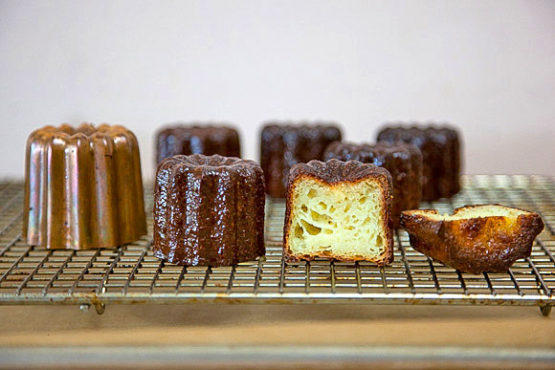
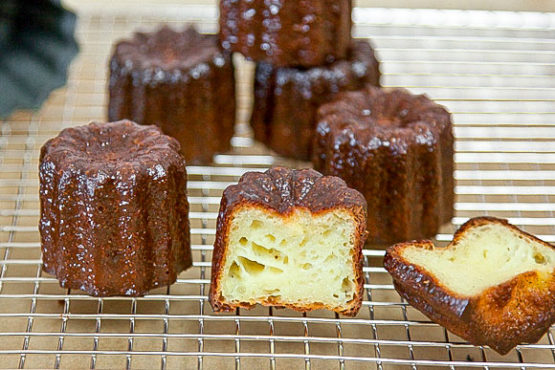
One rather odd recipe, originally attributed to Michel Roux then later to Nick Malgieri, calls for condensed milk and milk powder, which made me suspect that it’d been created during a rather lean time in France, the war perhaps? Living now in a time of abundance, I prefer fresh and less processed ingredients.
I gave it a try anyway, just for the sake of research. It turns out pretty canelés, though strangely cakey rather than properly custardy. I also didn’t particularly like the flavor, so that was the end of that. Now I need to figure out what to do with all this non-fat milk powder I have left over!
The problem I had with the rest of the recipes was not so much the flavor. How could you go wrong with milk, eggs, sugar, vanilla, and especially rum? But it’s in the consistency of the baking. I had the darndest time trying to produce the “perfect” canelés every time.
The problems are also not recipe-specific. I’ve had the same “soufflé” problem, for example, on pretty much all the recipes I tried – that’s when the batter expands too much during baking that it rises up and out of the molds, only to collapse into a royal mess in the oven.
So I began to focus more on the method rather than the recipe. I tried changing the eggs to an equal amount in yolks only but found the results too eggy to my taste. Belinda, the pastry chef at Manresa cautioned me not to whisk the batter, despite what most recipes said. That made a huge difference, I now stir, very gently. By accident, I also discovered that even the age of the eggs made a difference.
In the end, I settled on a slight adaptation of the ingredient proportions in one of Pierre Hermé’s published recipes but tweaked the process rather heavily, borrowing from Paula Wolfert’s sage advice and also from that maddening Chowhound thread.
Perhaps the toughest part to work on was the heat. I found that baking at a very long period at a very high temperature produced canelés that were so burnt the crust was practically carbonized. Over the last few weeks, I’ve been playing with different variables, producing canelés in all shades of a rainbow, making so many befuddling mistakes it drove me to the brink of insanity. But I stuck with it.
Whether it was stubbornness or madness, I stuck with it. And you know what, I got it. Finally. Allow me a minute to bask in my own personal glory. C’est moi qui l’ai fait!
I’m going to try and explain my method to you the best I can. And let me warn you I’ll be wordy. I hope that this canelé recipe will prove to be useful to just as many of you.
So, are you ready to give it a try? I hope I haven’t scared you off from making canelés altogether. Really, please don’t. As you can see success is entirely possible! Just do it!
Let’s begin with a few important things you need to keep in mind in your quest for the perfect canalé.
1. The molds – from copper to silicone
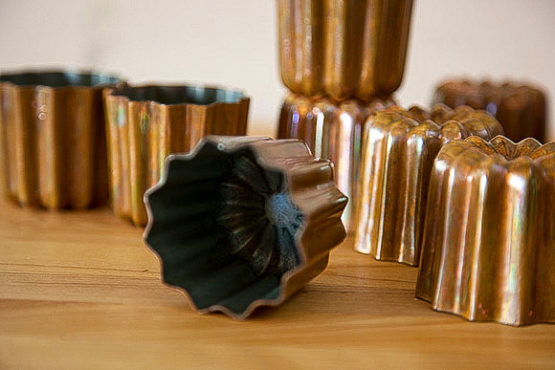
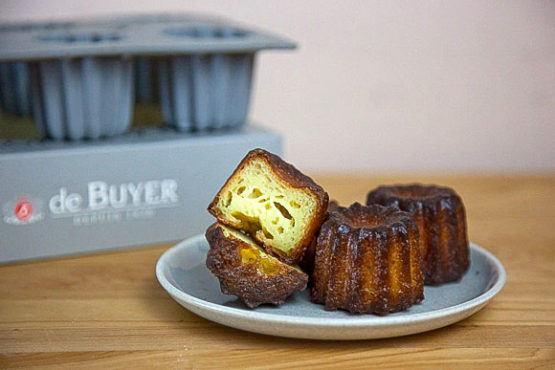
One of the characteristics of the perfect canelé is the stark contrast between the crisp, caramelized, evenly dark crust and the custardy interior. The best way to achieve this is with tin-lined copper molds that are made specifically for canelés. There are no two ways about it, if what you’re after is the perfect canalé, the copper mold is the way to go.
Unfortunately, saying the copper molds are not cheap would be an understatement. In Europe, they are about £10 each. In the US, Amazon sells them for about $20. Whether they’re worth it is entirely up to you.
But if you’re going to invest in copper molds, the one I recommend is made by Matfer Bourgeat, a French company – hey it’s a French pastry! Also matters here is the size, I go for the original, about a little over 2 inches in diameter on top, and 2 inches in height. I find that this particular size is the best for the crisp crust: custardy crumb contrast. Please remember that the copper molds will need to be cured before the first use. (See below for more info on the cure and care of copper molds.)
What about some alternatives if you’re not ready to sell your firstborn for the copper molds? I have seen people bake canelé in a ring mold or even mini muffin molds. They’re probably fine, but I would miss the fluted shape of the proper canelé. I think the best alternative is the silicone canelé molds. Yes, there I said it: silicone molds are indeed fine.
You will not get the perfect canelé you’re after, but if you do it properly, you can come pretty damned close to it. During my canelé madness, I tested a couple of different silicone mold brands and came up with one I liked and the method that gives the best, most consistent results. This is an interesting enough process to warrant a post on its own.
2. The beeswax
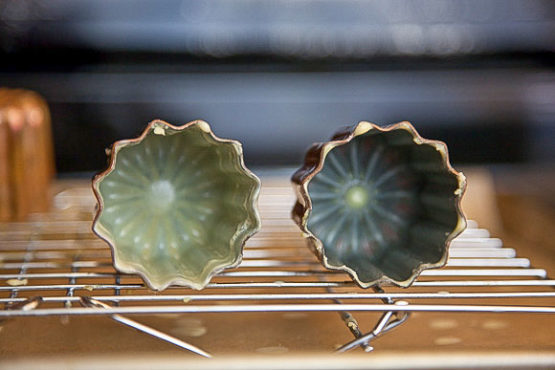
I was lenient with you about the molds. Though I much prefer copper, I find silicone perfectly acceptable. But you know what? I’m not budging on the beeswax. You need it. If you want to make proper canelés, with or without copper molds, you’ll need beeswax. It’s what gives the canelés their special mahogany shine and crispness.
It also adds a special flavor – more than one friend I’ve shared my canelés with asked if they’re made with honey. So, to me, it’s absolutely important that you use it. Without it, you could be baking something entirely delicious, but it sure ain’t canelé.
Beeswax is not that hard to find really. Next time you go to a farmers market, ask the honey seller there. Even if she doesn’t have it on display I bet she has some she could sell you. If you don’t have easy access to a farmer’s market this winter, call up a local honey producer in your area. Or you could always order it online. Also, Tremblay Apiaries, which sell at the Union Square Green Market on Fridays and Saturdays, and also offer it online.
I use a 1:1 ratio of beeswax to butter to coat my copper (and even silicone) molds. Some recipes will have you use a neutral oil like Canola or even clarified butter. I use butter anywhere I can get away with, so I prefer butter here. I find that if you’re making just enough beeswax/butter coating for your batch of canelés, there’s no need to bother clarifying the butter first. If you’re going to make a large quantity of the coating to keep for future batches as well, then perhaps clarifying the butter first to get rid of the butter solids will make your coating last longer.
Another important thing is the thickness -or the thinness rather- of the coating on the mold. Don’t be all like, yo I got me some beeswax so I’m gonna use it! You want to be very judicious with it, you don’t want a canelé with a coating of beeswax so thick it sticks to the roof of your mouth. Yes, that happens. No, it’s not fun.
The best way to achieve the optimal coating on the copper molds is to warm the molds a little first. Hot beeswax+butter mixture seizes up quickly on a cold mold, creating a coating that’s far too thick. So, warm the molds first. Then, rather than brushing the wax on, a process I found gave thick, uneven coating, I pour in the hot wax mixture, then pour it out and invert the mold over a wire rack set on a cookie sheet lined with parchment to drip off the excess. This is so you can reclaim the precious beeswax to use again.
3. Air is your enemy
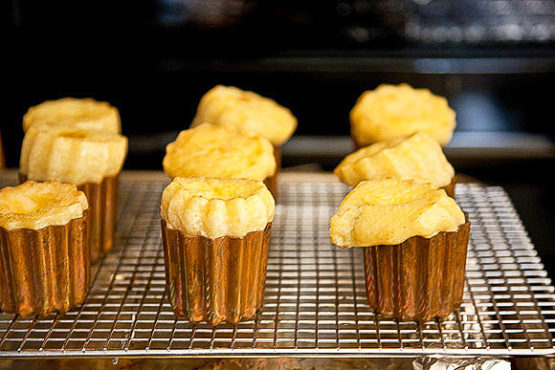
If you’re making a soufflé, air would be your friend. For canelés however, you really need to be careful not to incorporate too much air in the batter. In the beginning, I didn’t think it would be a problem, there’s so much liquid (milk) in the batter I didn’t think I could work that much air into it. But now I know better. I process the entire batter by incorporating as little air as possible. That means to stir and never whisk, and do it as gently as possible.
4. The temperature problem
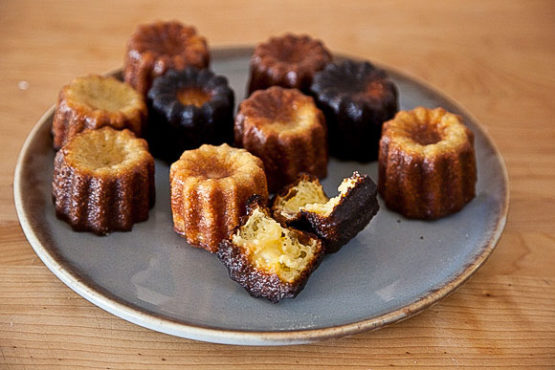
If there’s such a thing as the god of temperature, you should make a tribute to her/him right now. There isn’t one? Ok, how about Hestia, the goddess of the hearth?
Temperature is such a key thing with canelés, to get the proper dark mahogany crust, you’ll need to hit it first with super-high heat. I do it at 450F (230C), then I lower the heat (to 375F or 190C) to gently finish the cooking, keeping the interior moist and custardy while producing the characteristic canelé crust.
You also need to pay attention to the temperature of the molds and the batter. Following Paula’s advice, I keep mine cold, cold, cold. After giving them the wax coating I put the molds in the freezer to chill out for a while. When it’s time to fill them, I pull out my cold batter, fill it in, and then bake it immediately in the super-hot oven.
And herein lies a problem. Twelve frozen copper canelé molds filled with cold batter totally kill my wimpy oven. Every. Damned. Time. I checked the temperature in the oven and it dropped drastically after the molds went in. And my wimpy home oven took its sweet time cycling the heat back up.
This contributed to the soufflé problem too, as the batter expands too much when the heat is not high enough, then either collapses down around the molds making a grand mess, or collapses back into the mold itself, resulting in a squat, or shall we say height-challenged, canelés. Imperfect air circulation also means that you’ll have to bake the canelés longer to get the dark crust, resulting in an interior that’s a bit too cakey and not custardy enough in my opinion.
To fix this problem, I preheat my oven to 475F, then when the frozen molds go in I reduce the heat down to 450F. Then after 15 minutes I lower it again to 375F and continue to bake until finished. This is still not perfect, I just don’t think my oven has good enough air circulation to consistently produce a perfect 12-canelé batch, so now I’m only doing 6 at a time. If your oven is better than mine, then please feel free to do the big 12 batches, but if you run into the same problems I do, then try a smaller batch. That works better and more consistently for me.
5. The resting period
Every recipe asks you to rest your batter. Some say overnight, some say a few hours. From my experience, I get the most consistent results when my batter has rested at least 36 hours, and the best results when the batter has rested a full 48-hour period. Yes, as in TWO DAYS. Let me just tell you that I have all the patience of a Central Park squirrel on Four Loco, so when I tell you you need 48 hours, people, you need 48 hours, OK?
Ok, now you’re ready for the recipe. Have fun!
Canelés de Bordeaux
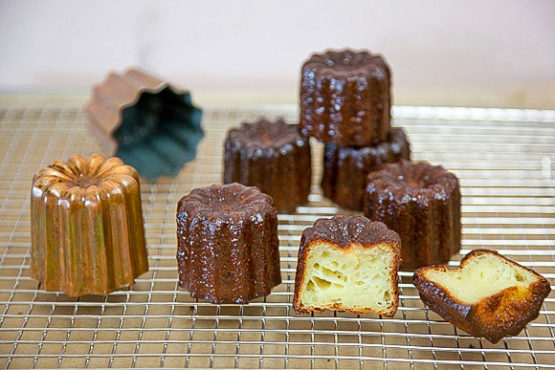
The ingredients are adapted from Pierre Hermé’s recipe from Patisserie of Pierre Hermé
- 500g | 2 cups | 50cl whole milk
- 50g | 3.5 tablespoons butter
- 1 vanilla bean or 3-4 teaspoons vanilla extract
- 100g | 3/4 cup +1 tablespoon AP (Plain) flour
- 250g | 2 cups (unsifted) powdered sugar
- 1 teaspoon sea salt (use a little less if table salt)
- 2 large eggs (Use the freshest eggs you could find, they make a difference.)
- 2 large egg yolks
- 1/4 cup rum
This amount makes about 20 canelés.
Make the batter – 2 days before you plan to bake the canelés.

Place the milk, butter, and vanilla bean (that you cut in half and scrape the seeds into the pot) over medium heat and bring to a boil. If you want to be precise it should be 183F. Remove from heat and let cool down while you get to the other ingredients. (If you’re using vanilla extract instead of a vanilla bean, just add the extract with the rum later.)
Measure and then sift together the flour, powdered sugar, and salt.
Stir the eggs and yolks together with a fork, don’t beat. I find it easier to pass the eggs and yolks through a strainer right into the dry ingredients. That way I don’t have to beat much air into the eggs at all. If you think this is crazy you can just pour the slightly beaten eggs into it and be done.
When the milk/butter/vanilla mixture is just a bit warm but not so hot – 120F or so, or cool enough to stick your finger in it and keep it there a few seconds without burning yourself – remove the vanilla bean halves. Don’t throw them away though, instead put them in another bowl of about the same size. Pour the warm milk mixture into the bowl containing the dry ingredients, and gently stir together until well-blended. You’ll see plenty of lumps in the batter, but that’s fine for now.
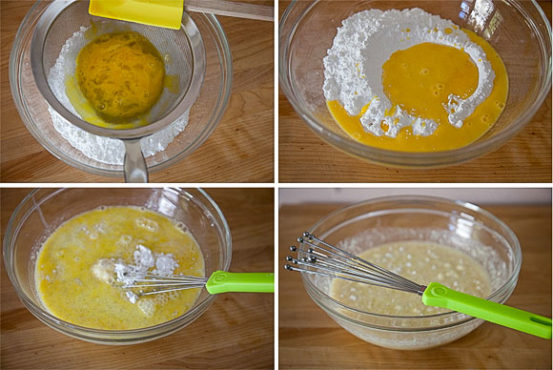
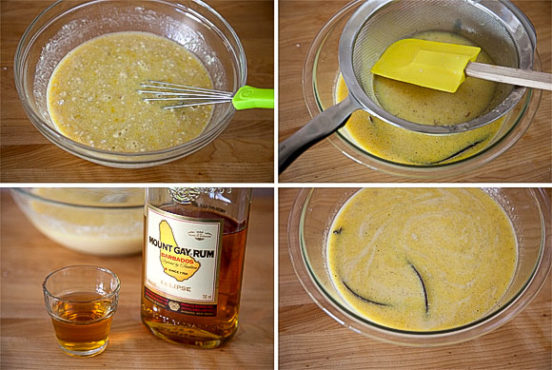
Strain the lumpy batter (over a fine-mesh strainer) into the bowl you put the vanilla bean in earlier, pressing the lumps through until you get a totally lump-free batter. Add the rum and stir until combined. Cover the bowl with plastic wrap (no need to press the plastic right over the surface of the batter) and place it in the fridge to rest for 48 hours. If you can remember it, stir it once after 24 hours and put it back in the fridge to continue to rest.
Coat the molds – 1 to 2 hr before you plan to bake

- 40g | 1.5oz beeswax, cut into small chunks (using a hot knife will make your life easier)
- 40g | 1.5oz | 3 tablespoons butter, cut into small chunks
Turn the oven on and set it to 475F (250C). Place the canelé molds on a baking sheet lined with aluminum foil, then place the baking sheet in the oven.
Meanwhile, melt the beeswax in a very small pot over very low heat. Do this slowly and don’t let it burn. If you’re worried about the heat on your stovetop you could also do this on a bain-marie. When the beeswax is fully melted, remove the pan from heat and add the butter chunks. The residual heat from melting the beeswax should be enough to melt the butter. If not just pass the pan quickly over the heat again. Shake the pan or stir to blend the wax and butter until homogenous.
By the time your beeswax/butter mixture is ready, the molds should be warm enough. Remove the baking sheet with the (now warm) molds from the oven. Take another baking sheet, this time, line it with a piece of parchment paper, and place a wire rack on top of it. Find a sturdy pair of kitchen tongs and keep it at ready.
To coat the first mold, pick it up with a pair of tongs and place it on the wire rack, pour the hot beeswax/butter mixture into it. Then pour the beeswax/butter mixture back into the pan, shaking to remove the excess, and place the mold upside-down over the wire rack to drip off the excess. Then start the same process again with the next mold, then the next, until you’re done coating all your molds. Remember you could reclaim the excess beeswax/butter mixture from the parchment-lined baking sheet if you’re running low on the wax mixture. Just scoop it back into the pot and pass it over the heat again quickly until it’s melted.
This is a bit of a delicate balance so you might have to do it a few times to get it right. The mold has to be just warm enough to let the wax coat without lathering it on thick. If the mold is too warm, the wax won’t stick. In this case, let it cool a bit and pour the hot wax mixture in again. If the mold is too cold, the wax will coat too thick.
You’ll just have to put the mold back in the oven to melt the thick coating of the wax and then recoat it properly with a new layer of wax. While you’re doing this if the beeswax/butter mixture gets too cold it will solidify, so just pass the pot back over the heat until it’s melted again. Easy enough, yes?

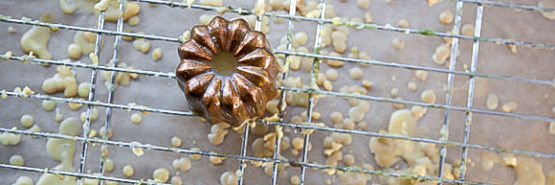
This whole thing sounds a little complicated, but it isn’t. It’s just a delicate balance you’ll quickly learn. Just make sure your wax coating looks like the correct one in the picture, and you’re good! I find a good pair of kitchen tongs does the job very well, but you could also use a pair of heat-proof gloves instead if you find the tongs a little too unwieldy. Just make sure you don’t try it with your bare hands.
When you’re done coating all the molds, put them in the freezer and let them rest for at least 1 hour before you bake.
Also, remove the resting batter from the fridge, the batter will have settled and separated a bit. Give it a gentle but thorough stir until the batter is again homogenous. Make sure you scoop all the way down to the bottom to get the batter that’s settled down there to reincorporate with the rest. Cover the bowl and put it back in the fridge.
Line another baking sheet, this time with aluminum foil, and place it on the middle rack in the oven to preheat.
If you have any beeswax/butter mixture left, remelt it and pour it through a fine-mesh strainer to remove any bits. You can keep it to add to your next round of canelé-making fun.
Bake the canelés – 1.5 to 5 hours before you plan to serve
Make sure the oven has been preheated for at least 30 minutes to get to the right temperature.
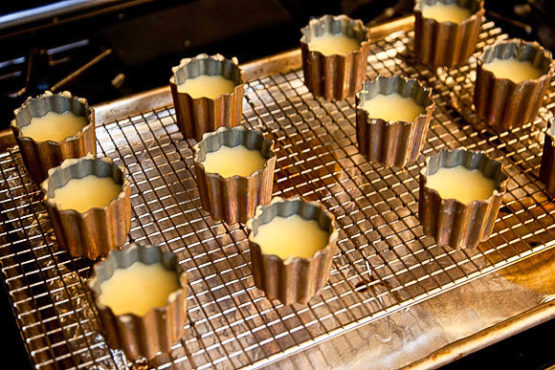
Take the batter out of the fridge, and give it a stir once again, very gently but thoroughly. I find it easier to ladle some of the batter into a Pyrex liquid measuring cup and then use that to pour the batter into each mold. So that’s what I recommend. Refill the Pyrex cup as needed.
Remove the molds from the freezer, and fill each one (all 12 if you think your oven can handle it, or just 6 at a time if your oven is as wimpy as mine) up to about 1cm or 1/2 inch to the top.
Remove the (now hot) baking sheet lined with aluminum foil that has been pre-heated in the oven and place it on the counter or the unlit stovetop. Arrange the molds at about equal intervals over it – directly over the sheet and not on a wire rack. Place the baking sheet back on the middle rack in the oven. Immediately turn the heat down to 450F.
Set your timer to 15 minutes. About halfway through the 15-minute period, turn the baking sheet once to ensure even baking.
At the end of the 15-minute period, turn the heat down to 375F (190C), set the timer to 45 minutes, and turn the baking sheet again once. Every 15 minutes or so, open the oven door to turn the baking sheet once.
The canelé batter will rise up over the molds, but only slightly. If you see the massive poufs like the picture above under the heading “Air is your enemy”, you’re hosed. So, keep an eye on your canelés as they are baking, especially around the first 10-20 minutes. If you see that they’re puffing up way too much and about to get out of control, don’t despair, take the whole baking sheet out of the oven and put it outside for a few minutes, the poufs should calm down and settle back into the molds.
You could very gently squeeze each one with a pair of tongs to help it along. When the batter settles back into the molds, put them back in the oven to continue baking. (Make sure you pause the timer when the molds are outside the oven and restart it when you put it back so you can keep track of the actual baking time.)


Your canelés should be done after baking at 375F for 45 minutes – give or take a few. If you’re unsure, just check it. About the 40-minute mark is usually good. Remove one mold and tap it upside-down to let out the canelé. If the crust is the desired color then you should be good.
Give it a gentle squeeze too, the canelé should give a little, you should be able to feel that the inside is wobbly and custardy. Cut or break one in half to check the inside just to be sure. Whatever you do, don’t bake until it totally hardens even when still hot, that would be far too much and you’ll get over-cooked canelés in the end. Not good.
I must say something here about the color of the crust. Yes, it is desirable to have a shiny, dark mahogany crust, but it should not be burnt. What you want is a perfectly caramelized rather than a carbonized crust. Get it? For some reason, there seems to be a general belief (especially here in the US) that the crust of the perfect canelés should be very, very dark, even burnt or bitter.
That’s all well and good if that’s your thing. But it’s not my thing. I find the taste of carbon rather unpalatable. So, if I were you I would err on the side of a slightly lighter exterior in favor of a custardy, perfectly wobbly interior and not a hint of carbon in the flavor.
I should also tell you, despite your best efforts, you will occasionally get the fault known – rather poetically – as the “white ass”. That’s when you have a pale spot or two, generally around the top (or the bottom when the mold is right-side up) of the canelés. This is nothing to commit seppuku over. It’ll happen. It’ll be fine. Just eat the evidence and don’t let anyone see.
So, now, when all your canelés bake up just as perfectly as you want them, remove the baking sheet from the oven. With a pair of tongs or a glove, pick up a mold, turn it upside-down, and tap it gently, your canelé should fall right out. Let them cool down a bit over a wire rack before you chomp into them or you’ll be sorry. The canelés are at their most perfect within a few hours after they’re out of the oven. They’re still good long after that, but the crust will soften so they won’t be at their best any longer than that.
There you have it. The method that gives me the best and most consistently perfect canelés. I’m pretty sure I told you everything in the clearest possible way, And yes, I promise you I’ll post the how-to post for the silicone molds tomorrow!
*How to cure and care for copper cannelé molds
Paula Wolfert has great advice on how to cure copper molds before you use them for the first time. Go read it and follow her instructions. (Scroll down to the bottom of the page.)
Most recipes will tell you never to wash the molds between use. I don’t wash mine either, but I hate the sticky films that develop after a few uses, so I’ve taken to rubbing the molds with a warm, wet cloth to gently scrub out the stuck-on bits and excess wax. Then I thoroughly dry the molds before I put them away between use. This way my molds are not sticky and gross, and frankly, I’ve not had any problem with the molds sticking during baking despite the contact with the wet towel.
Reviews
Absolutely Amazing Canelés Recipe
I stumbled upon SingleRecipe.com’s Canelés de Bordeaux recipe, and it was a culinary adventure that I will cherish forever. The step-by-step instructions were incredibly easy to follow, making it a breeze even for a baking novice like me. The results were nothing short of spectacular – the canelés turned out with a perfectly caramelized crust and a soft, custardy center. The rich, vanilla-infused flavor was simply divine! Thanks to SingleRecipe.com, I’ve unlocked the secret to creating these delectable French treats at home. It’s a must-try recipe that guarantees sweet success every time.
A Taste of French Delight!
I recently tried the Canelés de Bordeaux recipe, and it was an absolute culinary adventure! The step-by-step instructions were clear and easy to follow, making it a breeze to recreate these delectable French pastries in my own kitchen. The end result? Simply divine! The canelés turned out beautifully caramelized on the outside and wonderfully tender on the inside. SingleRecipe.com has truly outdone itself with this delightful treat, and I can’t wait to explore more of their recipes for more culinary adventures.
Delightful Canelés de Bordeaux Recipe!
I stumbled upon SingleRecipe.com’s Canelés de Bordeaux recipe, and it was a true gem. The step-by-step instructions were easy to follow, and the end result was pure heaven – perfectly caramelized on the outside and irresistibly soft on the inside. Thank you for sharing this culinary treasure!
Delightful Canelés de Bordeaux Recipe – A Sweet French Indulgence!
This Canelés de Bordeaux recipe is a culinary gem! With clear instructions and beautiful visuals, it’s a joy to follow, and the end result is a delightful treat that transports your taste buds straight to France. I can’t wait to explore more mouthwatering recipes on this fantastic website!
